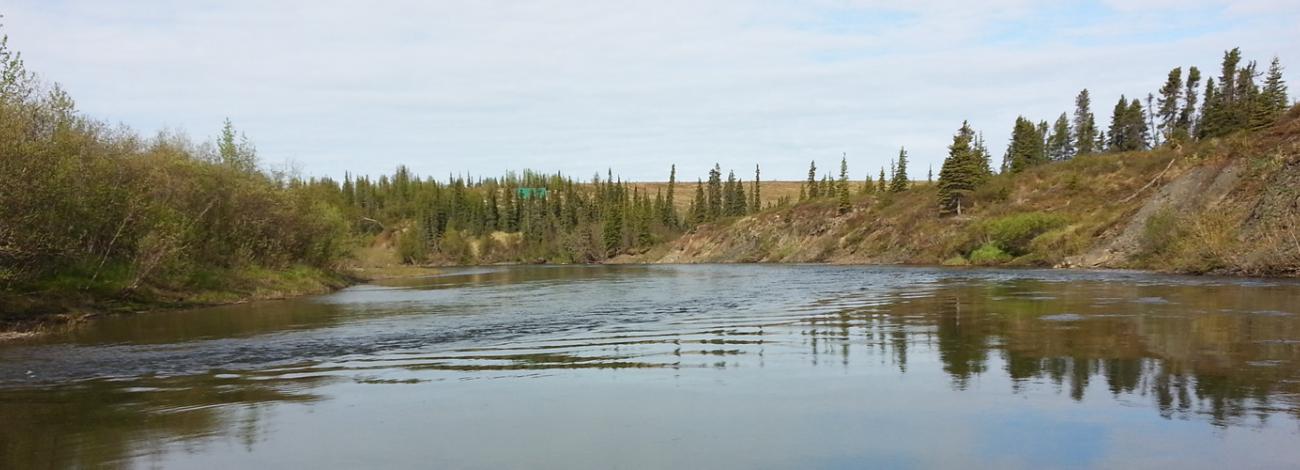
Unalakleet Wild and Scenic River
The Unalakleet River flows gently from the rolling Nulato Hills across a broad expanse of tundra to the coastal village of Unalakleet on Norton Sound. Located 400 miles from Anchorage, Unalakleet has approximately 800 residents and is accessible only by plane. At its headwaters, the Unalakleet River is swift and channelized; once it reaches the valley floor it begins to meander. For most of its length, the river has a varying pool/riffle nature, which offers a diversity of boating and fishing opportunities.
The upper 81 miles of the Unalakleet River are designated a National Wild River. A designated wild river is free of impoundments and generally inaccessible except by trail, with primitive shorelines and unpolluted waters. The BLM manages the Unalakleet National Wild River to provide high-quality primitive recreation opportunities, protect water quality, protect historic and archaeological values, and preserve the remarkable fisheries resources for which the river was designated.
Find out more about other wild and scenic rivers on the Alaska National Conservation Lands page or on the wild and scenic rivers program page.
Outstandingly Remarkable Values
- Fisheries
-
Fisheries
The Unalakleet River contains all five species of Pacific salmon, which help support a salmon fishery with runs exceeding 100,000 fish. The fishery is the most important resource value associated with the river, providing both subsistence, commercial, and recreation opportunities for residents and visitors to the National Wild River. The annual salmon runs provide the bulk of the income for the local community as well as reliable subsistence resources. Arctic grayling, arctic char, Dolly Varden, and whitefish are also found year round in the river.
- Subsistence
-
Subsistence
Subsistence fishing in the Unalakleet River occurs almost entirely in the lower portion of the river, which is outside Federal jurisdiction. Valuable spawning and rearing habitat for these salmon and other subsistence fish species exist in the headwaters and tributaries of the Unalakleet River, within the boundaries of the National Wild River. Many of the local villagers rely upon the resources of the Unalakleet River to support their subsistence lifestyle, especially Pacific Salmon, of which the King or Chinook salmon is the most prized. Similar to many watersheds in western Alaska, the Unalakleet Chinook Salmon run has experienced a sharp decline in recent years.
In the fall, powerboats are used as the primary means of transportation for subsistence hunting of moose along the river. Trapping for marten, lynx, fox, wolf, beaver, and muskrat is conducted in winter to provide cash income. Spring waterfowl hunting and egg gathering also fill out the subsistence diet.
- Recreation
-
Recreation
The Unalakleet River also supports the largest sport fishery in the area. From 2002 to 2006, an average of 782 anglers per year fished in the Unalakleet River. There is one commercial sport fishing lodge operating on the lower, State-managed waters. A few non-local anglers and people from the local area also go sport fishing there.
In addition to the sport fishery resources, wildlife resources are important from a commercial and recreational standpoint. Commercial hunting guide-outfitters depend on various wildlife species in the area. Moose, caribou, and bear are the main species sought. The Nulato Hills offer excellent opportunities for trophy-size brown bear and moose via airplane landings. Sport hunting along the river by non-local residents is minimal.
Along with hunting and trapping, additional opportunities for common winter recreation within the river corridor are similar to those in any Alaska winter environment, such as ice fishing, dog sledding, cross-country skiing, and snow machining. The Iditarod Trail parallels the river and is a popular route for various permitted events and activities such as the Iditarod Trail Sled Dog Race and the Iron Dog Snow Machine Race, as well as the Iditarod Trail Invitational and the Iditasport – both human-powered endurance races.
- Cultural Resources
-
Cultural
For thousands of years, the Unalakleet River was a major avenue of trade connecting people in Interior Alaska with coastal communities and the Bering Sea. A relatively short overland trail named the Kaltag Portage connects the interior Yukon River with the Unalakleet River, providing an efficient means of moving people and trade goods in this roadless area. The route later evolved into transportation corridor used by Russian merchants, American explorers, gold seekers and even the route of a telegraph line that was to eventually connect North America to Asia. Two BLM public use cabins are located along the Iditarod National Historic Trail near the river corridor.
Because of its long and varied historical use, the Unalakleet River valley contains many cultural resources which reflect its history. Formally recognized cultural resources within the wild river corridor include sites listed on the Alaska Heritage Resource Survey (AHRS), sites selected as historic sites under the Alaska Native Claims Settlement Act (ANCSA), and a 35-mile section of the Iditarod National Historic Trail and its associated sites and structures.
